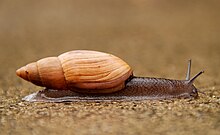Euglandina rosea
| Euglandina rosea | |
|---|---|
 |
|
| A live individual of Euglandina rosea | |
| Scientific classification | |
| Kingdom: | Animalia |
| Phylum: | Mollusca |
| Class: | Gastropoda |
| (unranked): | clade Heterobranchia clade Euthyneura clade Panpulmonata clade Eupulmonata clade Stylommatophora informal group Sigmurethra |
| Superfamily: | Testacelloidea |
| Family: | Spiraxidae |
| Genus: | Euglandia |
| Species: | E. rosea |
| Binomial name | |
|
Euglandia rosea |
|
Euglandina rosea, common names the rosy wolfsnail or the cannibal snail, is a species of medium-sized to large predatory air-breathing land snail, a carnivorous terrestrial pulmonate gastropod mollusk in the family Spiraxidae. This species is a fast and voracious predator, hunting and eating other snails and slugs. The rosy wolfsnail was introduced into Hawaii in 1955 as a biological control for the invasive African land snail, Achatina fulica. This snail is responsible for the extinction of an estimated eight native snail species in Hawaii. This has caused the snail to be added to the IUCN’s top 100 most invasive species.
The rosy wolfsnail lives for approximately 24 months. The snail takes 30-40 days to hatch and are then considered young (before they reach sexual maturity). Sexual maturity begins between 4-16 months after hatching. After reaching maturity they are considered an adult for the rest of their lifes. The snail is relatively fast moving at about 8 mm/s. The snail has a light grey, or brown body, with its lower tentacles being long and almost touching the ground. The shell has usual dimensions of 76mm tall and 27.5 mm in diameter. The shape of the shell tapers to a point at both ends () with a narrow oval to crescent shaped opening and a shortened axis of the spiral shell near the opening (truncated columella). The shell has a brownish pink color. The fully-grown adult snail ranges in size from 7-10 cm in length.
The rosy wolfsnail lives for approximately 24 months. This species found naturally in the southern portion of the United States, usually in hardwood forests and urban gardens. This species is a fast and voracious predator, hunting and eating other snails and slugs. The smaller species of prey are ingested whole. This gave it the nickname "the cannibal snail". The predatory snail uses slime trails to track its prey and potential mates, resulting in the rosy wolfsnail following these trails more than 80% of the time they are alive. The rosy wolf snail prefers to consume smaller snails because it is quicker and easier to eat the smaller snails. These prey snails include like the O'ahu tree snail and other small snails native to Hawaii and other Polynesian islands. When prey is found the rosy wolfsnail usually consumes the prey snail whole. The snail has also been seen to quickly suck the prey snail out of its shell which is slower than simply swallowing the prey snail whole. The snail is able to do this because it has no jaw plate. The snail is also specialized for carnivory, the mouth of the snail (buccal mass) being totally contained within a beak like structure (rostrum) that can be extended thus allowing the toothed tongue (radula) to be ejected past the mouth and into the snail’s prey. The radula is also adapted to be larger and have specialized the teeth into elongated cones.
...
Wikipedia
